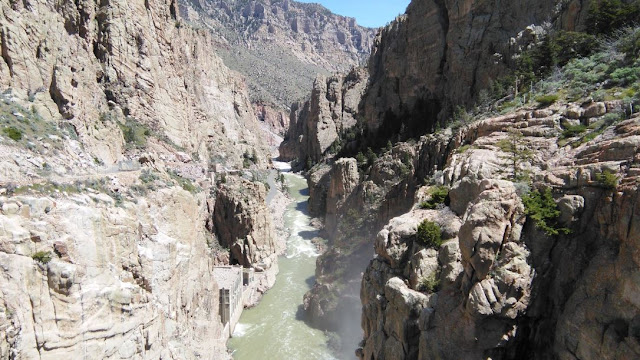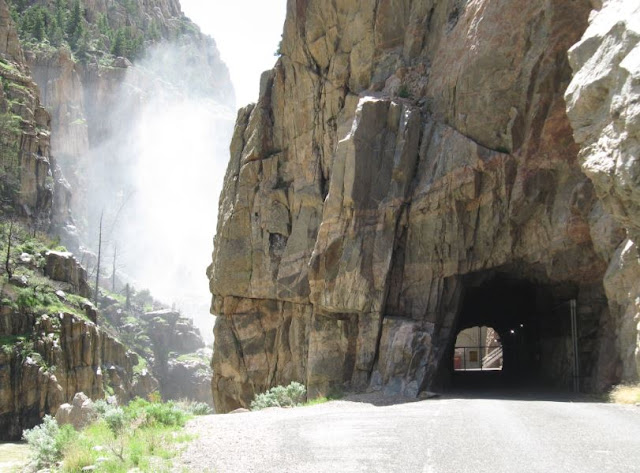A couple days at the Dam
The Buffalo Bill Dam is a concrete arch-gravity dam on the Shoshone River in the state of Wyoming. The dam is 70 feet wide at the base and 200 feet wide at the crest, with an original height of 325 feet. The concrete measures 108 feet deep at the base, tapering to 10 feet at the crest. It is anchored into Pre-Cambrian granitic rock on either side. The spillway is an uncontrolled overflow weir on the south side, 298 feet wide, dropping through a tunnel in the left abutment.Buffalo Bill had a vision to capture the spring melt waters running in the Shoshone River and transform the Big Horn basin from a semi-arid sagebrush covered plain into productive agricultural land. Cody and his partner attempted a few times to construct canals for irrigation, but their efforts failed. In 1904 the Shoshone Project was authorized by the State of Wyoming and the construction of the dam project began. The dam was designed by Daniel Webster Cole, who picked a perfect narrow opening in the canyon for the dam construction site. The first thing that had to be accomplished was to build a road to get to this rugged spot. The workers had to carve out three tunnels along that route. The road took most of a year to complete.
The first government contractor, Prendergast & Clarkson of Chicago, built a camp for the workers and began drilling to assess the geology of the site. They constructed a wooden flume to divert the river from the dam construction site, however the spring melt flood the next year destroyed the flume. This and the harsh winter weather set back and slowed the dam construction progress. Eventually the government fired Prendergast & Clarkson of Chicago and replaced them with two new contractors, Locher, and Grant Smith and Company. These companies also had their difficulties. The spring floods destroyed the construction site at least two more years. The dam was finally completed in 1910 after 6 years of very hard efforts.
The dam was originally named the Shoshone Dam but was renamed the Buffalo Bill Dam in 1946 to honor Buffalo Bill Cody. The dam was the tallest dam in the world at the time it was completed. In 1985 an additional 25 feet in height was added to the dam. Another fascinating thing about this unique dam is that there is no steel reinforcing in the concrete! The granite rocks removed from the construction area act as the reinforcing in the concrete dam.
There is a lot more to the story of hardships that occurred in building this incredible dam back at the turn of the 20th Century. The rugged land and harsh weather of Wyoming took its toll on the workers and the project itself. Seven workers were killed in the construction of the Buffalo Bill Dam.
Steve is pretty sure he can operate the giant winch.
Approaching the east end of the Buffalo Bill Reservoir.
Spectacular granite rocks at the opening of the canyon.
The opening to the canyon.
The Buffalo Bill Dam as seen from the reservoir side.
With the tremendous snow pack and spring melt off, the operators had the spillway open and tons of water was literally roaring out!
Gari thinks this is some sort of dam turbine valve.
Gari walking at the Buffalo Bill Dam.
View of the dam visitor center walkway paved with commemorative stones.
Close up on the stone pavers.
Gari atop the Buffalo Bill Dam, overlooking the Shoshone River canyon below.
A view of the crest arch of the dam; there's Gari out in the middle taking in the beautiful view.
Tons of water roaring out of the spillway below!
View of the downstream canyon from atop the dam.
We stopped after the third highway tunnel going into Cody and walked to the overlook to see the dam from downstream.
Below is the overlook view of the dam from downstream. It's easy to see the visitor's center, but the dam itself is harder to see as the concrete blends in with the surrounding granite. We also noticed the little road at the right down below and thought perhaps one day we could find that road and walk or drive down there and get a closer look at the downstream side of the dam...
Another view from the third tunnel overlook.
Below was the day that we found the little road into the Shoshone Canyon that leads to the dam. It turns out this was the original road built to enable the work crews to reach the dam construction site. Gari marvels at the steep granite canyon walls.
More perspective of the canyon with Gari observing the river at the stone bulkhead.
From here we can see the spray from the spillway release!
Below we spot a huge boulder captured in a crack. Hope that stays put!
Approaching the first of the original tunnels. Getting closer to the dam.
Spruce trees grow right out of the granite canyon walls.
Very close to the tunnel now.
That was no machine that dug this tunnel through solid rock. It was drilling, blasting, picks and shovels all the way. Inspector Number 2 collects photographic evidence to support this conclusion!
Gari looking back on the tunnel.
OK, we are almost to the dam site, Gari leads the way.
The canyon is deep down here near the dam.
The last tunnel... has lights and is closed by a locked gate at the far end. No access too close to the dam.
Steve saunters down to the closest access to the dam for a better view.
A view of the dam at the closest point of access. You can see the tiny people on top of the dam.
Zoomed out for a bit of additional perspective.
Looking down stream from nearby the dam.
Gari gets an action shot of the powerful rushing waters of the Shoshone River.
Steve looks onto the rushing waters.
Gari enters the last tunnel on a fact finding mission.
Headed back now, one last picture of the spillway spray.
Going back down the narrow canyon with one eye on the precarious and enormous rocks above us...







































No comments:
Post a Comment